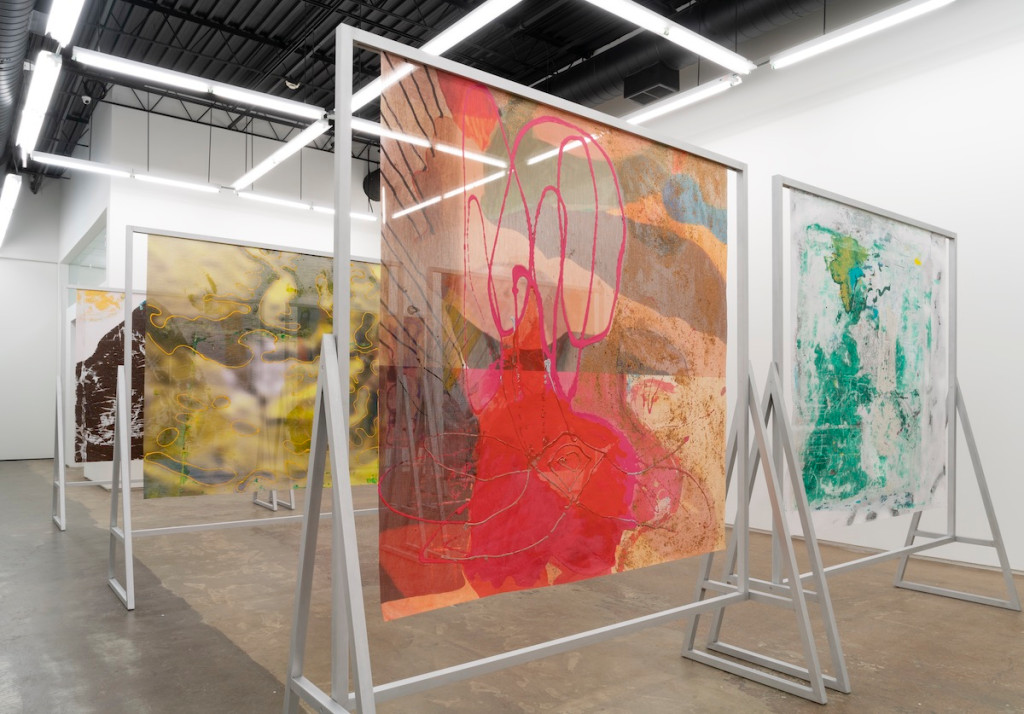[ad_1]
When she was contacted about the possibility of an interview, Candida Alvarez suggested doing it at 2 p.m. on February 22 at Monique Meloche Gallery in Chicago, where she is currently having a solo exhibition. “Twos are my special number because I was the second child born on the second day of the second month,” she told me, surrounded by her mixed-media paintings. “That’s why I chose two o’clock to meet. I just like flirting with the obvious.”
Alvarez’s art, on the other hand, is anything but obvious. For over 40 years, the Brooklyn-born, Chicago-based artist has played with the possibilities of paint in a terrifically sundry array of styles: controlled explosions of color fields, highly structured and unerring geometries, and subdued figural portraits—including at least one pastel picture of her pet dog. Her choice of surfaces for her abstractions has been as unpredictable as her artistic trajectory, ranging from canvas to vellum to cloth napkins.
All this delightful hodgepodge was on view in Alvarez’s first major institutional exhibition, at the Chicago Cultural Center in 2017, which cemented her reputation as a local legend. For Alvarez, who is now 65, that year was exceptional. Among her other accomplishments in 2017 were a collaboration on camouflage-like menswear with Rei Kawakubo for Comme des Garçons and a series of outdoor paintings installed along the Chicago Riverwalk. But she also experienced overwhelming losses in a span of months: the death of her father, followed by Hurricane Maria’s devastation of her family’s home in Puerto Rico.

Chester Alamo-Costello/Courtesy Monique Meloche Gallery
“One of the things about trauma is, you don’t know what it’s like until you live it,” Alvarez said. “You don’t know how you’re going to be. It felt like I had lost this connection to family, to the land. I just knew I had to work, but it was driving me nuts that I couldn’t because I had to deal with finding my mother and sister, and I was teaching. But when I walked into the studio, I devoured what was there. I just knew I had to find solace.”
The seven abstract paintings on view at Monique Meloche (through March 21)—swirling with bold, high-keyed daubs and freely meandering lines—emerge from this period of pain and prosperity. They are composed of acrylic that Alvarez painted and poured on PVC mesh, which she then suspended like laundry hung up to dry within freestanding, stark aluminum frames reminiscent of mobile whiteboards. The colors mingle with latex ink printed on the porous surfaces, which Alvarez originally made as proofs for the Riverwalk installation. Saved from disposal, the heavy sheets now have a curiously magnetic presence. They are open and vulnerable—exposed on both sides—coaxing you to get close to search their intricacies.
The exhibition’s title, “Estoy Bien,” refers to the phrase Alvarez kept hearing while searching for her mother and sister in the aftermath of Hurricane Maria. “I’m fine” became a phrase that survivors said over and over to reporters and volunteer groups. “But we all know what that means,” Alvarez said. “That means: We’re holding. It’s an abbreviation, a pause. You don’t want to get into it. It’s a way to hold space.” The words appear in the very first painting that greets visitors, scrawled in a speech bubble amid vibrant waves of blues, greens, and pinks corralled by luminous, dripping lines; in one corner, a butterfly with dripping wings takes flight.
Just over 11 feet wide, Estoy Bien (2017) is the largest and most enveloping work on view. It is also the first painting of this recent series that Alvarez finished, and, according to the artist, the most literal. “I was able to just dump everything, all the emotion into this piece,” she said. “It allowed me to be present. It gave me back my studio. I was in control again. The painting and I were like looking at each other and saying, Yeah, we’re okay.”

Courtesy the artist and Monique Meloche Gallery, Chicago
Creating this suite of what she calls “air paintings” proved to be deeply nourishing. Alvarez considers the works spaces to enter—she says their painted skins protect her. “They helped me find comfort,” she said. “They helped me remind myself of me, what is at the core of my being. I had them laying around, and I was sad. I felt there was something in them, so I started painting on the floor, on the walls, with my whole body.”
One can get a sense of Alvarez moving, almost dancing, in her studio through the gestural lines of the paintings in the gallery’s backroom. Imposing and neatly arranged—in pairs—these smaller, semi-sheer works resemble windows onto abstract environments that appear to shift before one’s eyes. Joyously freeform blobs of color spill across their surfaces. In Jellow (2018), mustard lines of acrylic worm through a printed background of greens and yellows; the acid-like pattern is left hazy, but it’s suggestive, like an out-of-focus photograph. In Walking in Blue (2018), warm, exuberant stains pool and collide into each other while rivers of deep blues weave above them. The verso is surprisingly simple, charting the routes of these rivers as they bled through the mesh, leaving textural splotches that bound gracefully through space.
For Alvarez, the conversations these works inspire are endless. “I feel like my paintings are talking back to me,” she said. “I love that they’re very chatty. They give me peace. They give me memories. And sometimes, they’re just distractions. But good ones—because I’m trying to find rest and peace.”
[ad_2]
Source link

